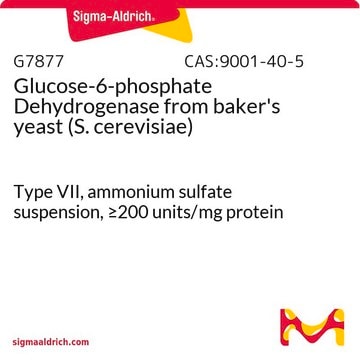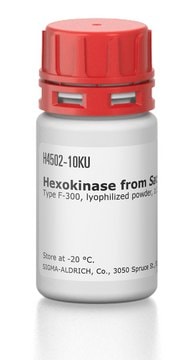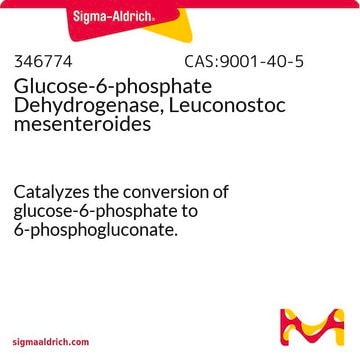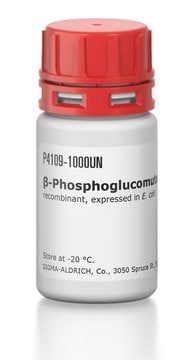The molecular weight of this enzyme has not been determined. However, Biochem. Biophys. Res. Comm. 59, 894 (1974) reports a molecular weight of 55,000 daltons for the monomer. The enzyme is functionally active as a dimer or tetramer.
G5885
Glucose-6-phosphate Dehydrogenase from Leuconostoc mesenteroides
lyophilized powder, >= 550 units/mg protein (biuret)
Sinónimos:
G-6-P-DH
About This Item
Productos recomendados
origen biológico
bacterial (Leuconostoc mesenteroides)
Nivel de calidad
tpo
Type XXIV
Formulario
lyophilized powder
actividad específica
>= 550 units/mg protein (biuret)
mol peso
128 kDa
composición
Protein, 15-40% biuret
aplicaciones
agriculture
actividad extraña
6-Phosphogluconic dehydrogenase, hexokinase, NADH oxidase and NADPH oxidase ≤0.005%
PGI ≤0.01%
temp. de almacenamiento
2-8°C
¿Está buscando productos similares? Visita Guía de comparación de productos
Descripción general
Aplicación
Acciones bioquímicas o fisiológicas
Definición de unidad
Forma física
Palabra de señalización
Danger
Frases de peligro
Consejos de prudencia
Clasificaciones de peligro
Resp. Sens. 1
Código de clase de almacenamiento
11 - Combustible Solids
Clase de riesgo para el agua (WGK)
WGK 3
Punto de inflamabilidad (°F)
Not applicable
Punto de inflamabilidad (°C)
Not applicable
Equipo de protección personal
Eyeshields, Gloves, type N95 (US)
Elija entre una de las versiones más recientes:
Certificados de análisis (COA)
¿No ve la versión correcta?
Si necesita una versión concreta, puede buscar un certificado específico por el número de lote.
¿Ya tiene este producto?
Encuentre la documentación para los productos que ha comprado recientemente en la Biblioteca de documentos.
Los clientes también vieron
Protocolos
To measure glucose-6-phosphate dehydrogenase activity, beta-nicotinamide adenine dinucleotide phosphate is used in a spectrophotometric rate determination assay at 340 nm.
-
What is the molecular weight of Product No. G5885, Glucose-6-phosphate Dehydrogenase?
1 answer-
Helpful?
-
-
In which solvent can Product No. G5885, Glucose- 6-phosphate Dehydrogenase from Leuconostoc mesenteroides, be dissolved?
1 answer-
The product can be dissolved at 1 mg/ml in 5 mM glycine buffer , pH 8, (with or without 0.1% BSA)or in deionized water at 1 mg/ml (buffer is preferable).
Helpful?
-
-
What is the Department of Transportation shipping information for this product?
1 answer-
Transportation information can be found in Section 14 of the product's (M)SDS.To access the shipping information for this material, use the link on the product detail page for the product.
Helpful?
-
-
What are the differences between Product No. G8529, Glucose-6-phosphate Dehydrogenase and Product No. G5885, Glucose-6-phosphate Dehydrogenase?
1 answer-
Product No. G8529 is a recombinant protein from Leuconostoc mesenteroides, expressed in Escherichia coli. Product No. G5885 is a non-recombinant protein from Leuconostoc mesenteroides.
Helpful?
-
-
Can solutions of Product No. G5885, Glucose-6-phosphate Dehydrogenase, recombinant from Leuconostoc mesenteroides, be stored?
1 answer-
Solutions in buffer may be aliquotted and stored frozen at -20°C for about 1-2 months.
Helpful?
-
Active Filters
Nuestro equipo de científicos tiene experiencia en todas las áreas de investigación: Ciencias de la vida, Ciencia de los materiales, Síntesis química, Cromatografía, Analítica y muchas otras.
Póngase en contacto con el Servicio técnico












